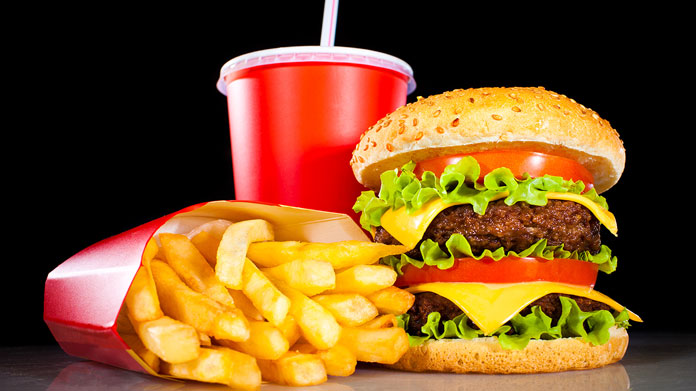Introduction:
Foods prepared in restaurants are often meant to look, smell and taste great. However, nutrition is usually compromised for taste, smell and appearance. Usually, menus would feature main dishes drenched in butter or rich sauces, salads with creamy dressings, and few whole grains, fruits and vegetables. To ensure continuous weight management, pay attention to fast foods especially when consumed outside your home. Note that it is possible to eat healthy even when you eat out.
Fast foods:
Frying is often the favorite cooking method in the fast-food industry and as a result, fast foods are often high in fat and kilojoules. Ample servings of sauce and other condiments indicate high amount of salt. For chicken meals, choose flame grilled chicken and serve with large tossed salad and baked potatoes. If Burger, order for a regular burger and skip the cheese. Burger can also be eaten with a side salad or a small portion of cheese. Pizza and toasted sandwiches are better if you choose lower fat toppings and fillings such as mushrooms, peppers, brinjals, asparagus, artichokes, grilled chicken and onions.
Fast foods from the supermarkets:
These include low-fat yoghurt, fresh fruit and whole wheat roll, Salad, Potato salad and fresh fruit, Spinach salad and are recommended food choices when dining out.
Tips for eating out at a restaurant:
Don’t go to a restaurant very hungry. Eat a small snack such as a piece of fruit or order a cup of broth-based soup or small salad to deal with hunger first. Give preference to restaurants that offer variety. Ask about preparation methods. Watch for the words used to describe the food. Words such as “grilled,” “broiled” or “steamed,” indicate that the food is cooked with less fat, while “fried,” “breaded,” “smothered,” “alfredo,” “rich” and “creamy.” refer to food prepared with abundant oil and cream.
Request that items be prepared with less oil or cheese, Request that the bread should be replaced with salad (with dressing on the side) and an appetizer portion of a main meal. Ask that all visible fat including the skin of chicken be removed before cooking.
Other things include: know what you are getting into before going to the restaurants. Some of them have menus online where you can choose from before ordering. Eat lighter earlier that day.
More recommended food choices when dining out:
Look for whole-grain breads, pastas and sides; opt for foods with healthy fats such as olive oil, avocados, nuts and seeds; be sure to order lots of fruits and veggies; and go for lean meat. Ask if salad dressings, sauces can be served on the side so that you can control your intake. Ask how large their portions are. Ordering a starter as your main course may be an option for you.
Things to consider:
Ask if baked and broiled items are basted while they cook. Ask if vegetables are cooked in butter or margarine. Ask about substituting a high fat, high-kilojoule, item with something lower in fat or kilojoule. Ask your server to modify your meal to be healthier. Ask for a salad in place of the usual fries or chips with a meal. When ordering a salad, always ask for the dressing on the side. Add oyster or sea food platter without fried items. Poultry and fish are low in fat and can be prepared with minimal use of oil and still taste nice.
Others:
Order grilled items served as a ladies’ portion. Note that many grilled items are basted in oil. Order healthy side dishes like salad baked potato or fruit. You can top baked potato with vegetables, salsa or chili. Request for a meal not on the menu. For example, ask for any vegetarian dish the chef can prepare or preparing grilled chicken and steamed vegetables. Add physical activity before or an after the meal. A stroll after the meal is good for digestion.
Buffet Dining:
Restaurants who offer this method are ideal. Healthy food items can be self-selected. Portion size can be controlled. There may be no opportunity to order anything outside the menu.
Healthier version of meals:
See below healthier versions of different foods.
Potatoes, rice and pasta:
Baked potatoes, steamed rice and pasta served without cream sauce. Pasta salad and fried rice contain a large amount of fat. Serve baked potatoes with cottage cheese instead of sour cream.
Vegetables:
Grilled, boiled, baked and steamed vegetables are good choices. Request that no additional cream, margarine, butter or cheese be added after cooking.
Desserts:
fresh fruits, served without cream or ice cream. Divide large portions into two. Eat half and take the other half home. Splitting food before you start eating makes it easier to avoid overeating.
Chinese foods:
Mixed Chinese greens, beef with broccoli along with steamed rice. Steamed spring rolls, stir-fries with chicken vegetables and tofu.
French cuisine:
Ask for onion soup as a starter.
Indian spice:
Lentil soup.
Steakhouse sizzlers:
Start your meal with a green salad, sprinkled with a little oil and balsamic vinegar.
Conclusion:
Consistency is a key to weight management. If you usually eat outside your home. Pay attention to your fast food, take away and restaurant meals. You can make a request to alter cooking methods, dressings, desserts. You can order healthier versions of meals and you can control portion size.

